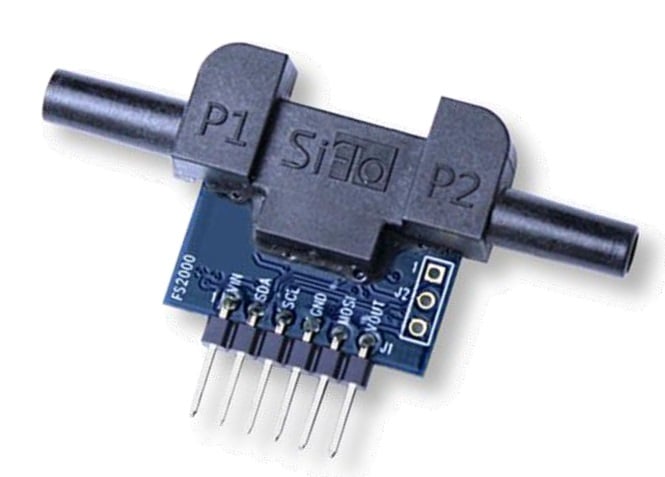IDT’s new flow sensors use the
calorimetric principle and a special sensor coating to provide
robustness and long-term reliability when measuring gases and liquids.
IDT offers two series of these MEMS mass flow sensors: the FS1012 and the FS2012. Both of these low-power flow sensor series are capable of measuring either gas or liquid. And because the sensor is covered with a silicon-carbide coating, it is protected from abrasive wear. However, a single sensor module can’t measure both gas and liquid; rather, the device’s full part number determines if the sensor is designed for measuring gas or liquid.

Figure 1. IDT’s FS2012 MEMS flow sensor module. Image take from datasheet.
What Is the Calorimetric Principle?
These mass flow sensors operate using the calorimetric principle. If you’re not familiar with this type of sensing technology, then IDT’s datasheets won’t be too helpful aside from mentioning, briefly, that this sensing method is based on the thermo-transfer principle and that “the thermopile output changes according to the rate of flow, and it is proportional to the amount of heat sensed from the heater.” Well, a little more information would be appreciated, but these documents are datasheets—these aren't whitepapers explaining, in detail, the relevant operating principles.To quickly summarize the calorimetric principle: it refers to a measuring element, or elements, used in conjunction with a heat source to determine how much energy (heat) is absorbed by the flowing medium (gas or liquid). The resulting temperature change is an indication of flow.
Calibrated Measurements and Digital (I2C) Output
IDT happily offers their new MEMS flow sensors with and without calibrated output data. While the FS2012 series provides a calibrated flow measurement output as well as digital (I2C) and analog (0 to 5V) output options, you can save some money (more than half) by opting for the analog-only version (the FS1012), which does not provide calibrated flow measurement data.Personally, I find it accommodating of IDT to offer both calibrated and non-calibrated versions. If I were to use one of these flow sensors, I would most likely choose the non-calibrated version. I say “most likely” because the FS1012 datasheet does not provide any flow accuracy information, and I would be placing a call to IDT with the hopes of getting some kind of accuracy data before ordering the part. If I were still in the dark after chatting with IDT, I would probably use the calibrated version.
By the way, the datasheet for the calibrated version (FS2012) specifies ±1% (typical) and ±4% (maximum) accuracy for gas measurements, and ±2.5% (typical) and ±7% (maximum) for liquid measurements (see image below).

Figure 2. IDT’s FS2012 MEMS flow sensor accuracy specification. Table taken from the datasheet.
Single-Ended Circuit vs. Differential Circuit
The FS1012 module (which offers only analog output) can be used in a single-ended configuration or a differential configuration (see image below). However, the datasheet is not clear as to why one circuit would be used over the other. I can surmise that the differential circuit would yield higher-quality measurements, since differential signaling generally reduces noise, but it would be nice to have some clearer guidance regarding how to design the interface between the sensor and the processor.
Figure 3. Analog interface options. Diagram taken from the datasheet.
A Quick Review of Some Specifications
The FS1012 sensor has an impressive response time of 2ms. However, the response time of the FS2012 sensor is not listed anywhere in the datasheet. Frankly, I’m surprised that this information is missing, and I assume that the response time is similar to that of the FS1012 sensor. But it would be best to clarify this oversight with a call to IDT.Another interesting discrepancy is that the FS2012 datasheet points out that the “board circuitry is not protected from liquids,” whereas the FS1012 datasheet doesn’t have this note. This seems like fairly important information since some users might assume that a device designed for measuring liquid flow would be resistant to liquids.
Finally, when considering that these sensors have an internal heating element, they draw a relatively low amount of current (20mA for the FS1012, and 30mA for the FS2012).







No comments:
Post a Comment